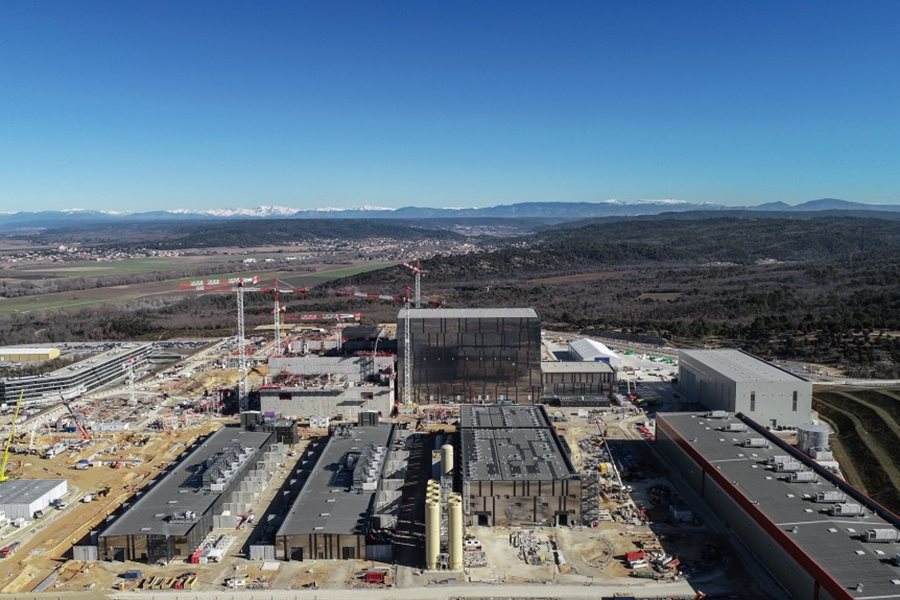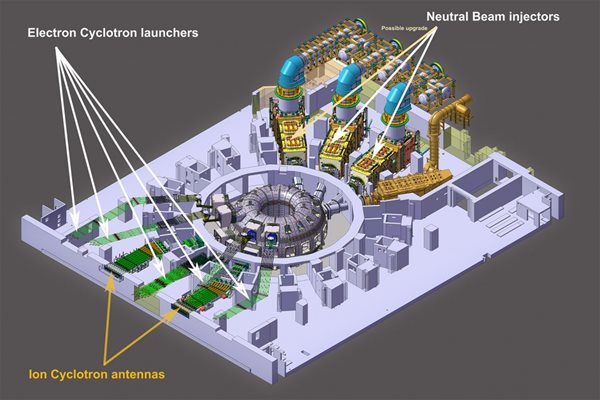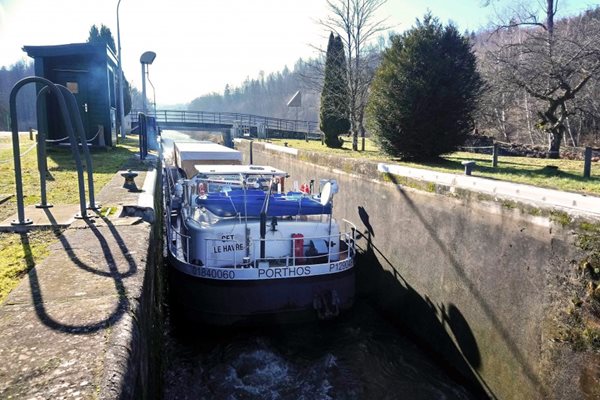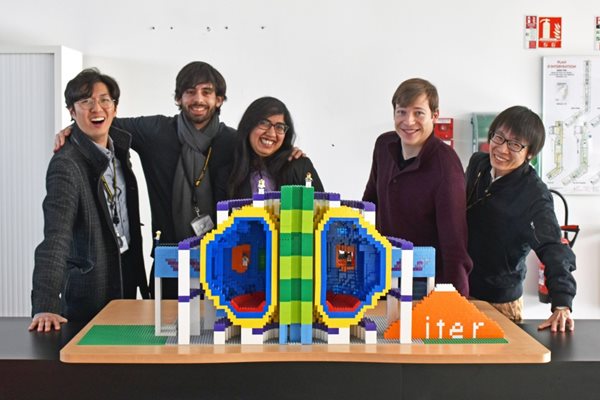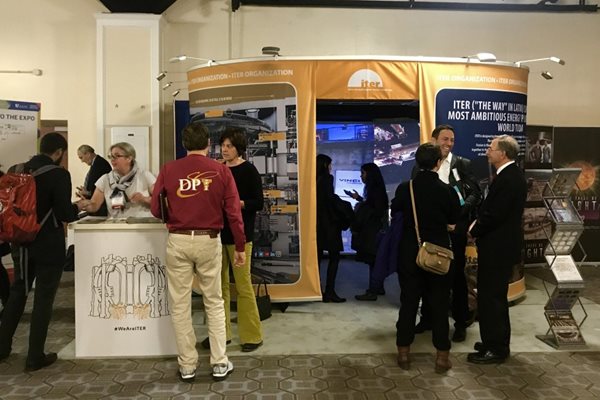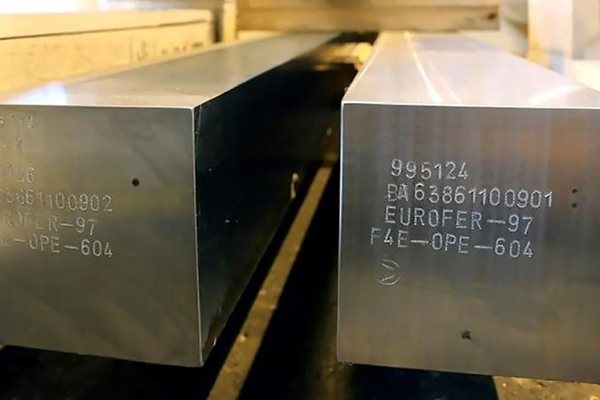
you're currently reading the news digest published from 11 Feb 2019 to 18 Feb 2019
featured5
of-interest1
press5
featured
On site | Drone survey on a perfect day
There are days in winter when the skies over Provence are perfectly transparent. Snowy peaks 200 kilometres away appear close enough to be touched and farms, country roads and villages are all revealed in sharp detail. A drone flying over the ITER site on such days captures every single iron bar, scaffolding tower, or embedded plate in the Tokamak Complex; every insulator in the electrical switchyard; and every component carefully wrapped in green plastic in the site's storage areas. This new harvest of images from early February also reveals the broader setting of the ITER Project, among the rolling hills and plowed fields along the Durance River valley—a futuristic enclave in an unchanging environment.
Heating | A pinch of moondust in the ITER plasma
One day in the distant future, fusion plants might be fuelled by helium 3—an isotope that is extremely scarce on Earth but reputed to be abundant on the Moon. But long before the advent of helium 3 fusion¹ (if ever it is achievable) this rare element will play a role in heating the ITER plasma. In the initial stage of ion cyclotron resonance heating, a pinch of helium 3 will be puffed into the vacuum vessel to boost the efficiency of the system. Ion cyclotron resonance heating (ICRH) is one of the three external heating systems—along with electron-cyclotron resonance heating and neutral beam injection—that will be implemented on ITER. In ICRH heating, radiofrequency waves are injected into the plasma to transfer energy to the charged particles, or ions, that make up the fusion fuel. By generating waves at a frequency that matches the oscillation of the ions perpendicular to the magnetic lines (the 'cyclotron' frequency) ICRH waves resonate with plasma ions, which leads to energy transfer from the radio waves to the plasma. And of course 'transfer of energy' is a scientist's way of saying 'heating' ... Within certain limits and for a given magnetic field, ICRH waves can be 'tuned' to match the cyclotron frequency of specific ion species. An exact match between wave and ion cyclotron frequency allows for what plasma physicists call 'fundamental heating'; a wave frequency twice as high as the ion cyclotron frequency is called 'second harmonic heating.' 'Generally speaking, fundamental heating has a better absorption efficiency than second harmonic heating at low plasma temperatures, i.e., for conditions characteristic of the start-up phase in an ITER plasma,' explains Mireille Schneider, a physicist in the ITER Confinement & Modelling Section. 'But due to the properties of ion cyclotron waves, fundamental heating works on a minority ion population and not on the majority bulk ion population of the plasma.' When the cyclotron frequency of the majority ions is half that of the minority, the same ICRH wave frequency resonates with both species and operators can briefly use fundamental minority heating as a 'starter' to bring the majority to a temperature level that allows second harmonic heating to take over. This is where helium 3 enters stage—its cyclotron frequency happens to be exactly twice that of tritium, making it the perfect starter ion for ICRH heating in a deuterium-tritium plasma. (See box.) 'The ITER ion cyclotron antennas have a frequency range of 40 to 55 MHz,' explains Mireille. 'When we tune them to about 53 MHz, the frequency corresponds to the fundamental resonance of helium 3 and also to the second harmonic resonance of tritium.' In the initial stage of ICRH heating, the radiofrequency waves can efficiently heat the minority helium 3 ions through fundamental heating, which in turn start to heat the majority tritium ions through collisions. Although not a direct 'target' of ICRH heating, deuterium ions are caught in the high-speed billiard game that ensues and their energy level (their temperature) rises parallel to that of the tritium ions. As the tritium ions become hotter, second harmonic ion cyclotron heating becomes more efficient. After a few seconds, the energy can directly be transferred from the ICRH radio waves to the tritium ions (and hence to their deuterium counterparts) through collisions, and the puffing of helium 3 into the plasma can be stopped. Which is fortunate for the economics of fusion. Helium 3—used in minute quantities for cryogenic applications, neutron radiation detection and medical resonance imaging—is as rare as it is expensive ... What percentage of helium 3 will be needed to optimize ICRH heating and how long it will need to be puffed into the plasma are still open questions. 'The ITER Science Division is working on different models and scenarios and so is the fusion community as a whole, particularly through the International Tokamak Physics Activity (ITPA),' explains Mireille. 'As of today, we don't have all the answers but we can reasonably estimate that we'll need to puff a few percent of helium 3 for ten seconds or less ...' In many ways, fusion is still a science in the making. And it is only through ITER operation that long-sought answers will eventually be provided. ¹ - Helium 3 (³He) can fuse with deuterium and also with itself. The ³He+D reaction occurs at temperatures in the one billion degree range and—contrary to deuterium + tritium fusion—only releases charged particles. In principle this means that no neutron flux will activate and alter the chamber walls. In reality, the ³He+D reaction does release some neutrons, since part of the deuterium in the plasma will inevitably fuse with itself. The ³He+³He reaction, which occurs at even higher temperatures, presents better prospects; its energy yield (12.9 MeV) is still high and it releases no neutrons. Both reactions unfortunately come with a slight technicality: the crust of the Moon is the closest place where ³He can be procured in significant quantities ...
Delivery | 2,000 km through canals, locks and tunnels
When the thruway is closed, one takes the back roads. And when it's low-water season on the Rhine-Rhône canal, a barge leaving Switzerland for the Mediterranean has no other choice than to head north, then west, until eventually reaching the Rhône river valley through a network of small-gauge canals dotted with locks and tunnels. For the last of the cold boxes needed for the ITER cryoplant, the journey must have seemed like a leisure cruise through magnificent winter scenery. For the transport organizers—ITER's global logistics provider DAHER and its contractor Compagnie Fluviale de Transport—it was a highly delicate operation. The 63.5-tonne load travelled aboard a specialized heavy-duty barge, the Porthos, whose dimensions barely allowed it to pass through some of the locks. To accommodate the height of the cold box (five metres), the waterline of the barge had to be lowered sufficiently to allow passage through the low-ceilinged tunnels while keeping the ship's hull at a safe distance from the bottom of the canal. This was achieved by adding a precisely calculated amount of ballast to the component's weight. Despite these challenges, barge transportation has its advantages. 'It offers a very smooth ride, with very few accelerations and vibrations,' explains DAHER's operation manager Laurence Prudhomme. 'And it's also cheaper than road transportation.' Components on a barge travel slowly, but in safety and comfort. From Switzerland, where the cold box was manufactured under an ITER India contract, to the ITER site, where it is expected on 20 February, the journey will have lasted more than three weeks. In all, a voyage of almost 2,000 kilometres through eight different canals, four tunnels and 250 locks. Click here to view a short video of the barge as icebreaker.
Monaco Fellows | A hand in shaping ITER
For the sixth time, ITER is welcoming a group of five young researchers as part of the Monaco-ITER postdoctoral fellowship scheme. Working alongside experienced scientists and engineers at ITER, the Monaco Fellows will be pursuing research assignments in areas of crucial importance to the project. Created in 2008 and renewed in 2018, the Monaco-ITER Partnership Arrangement enables ITER to offer promising young postdocs two-year assignments in ITER scientific or technical divisions. The ITER Project benefits from their fresh ideas and novel approaches while, for their part, the Fellows can test newly acquired expertise and skills at the forefront of their respective fields. And experience has shown that the ties created by the Monaco Fellows during their stay at ITER last well beyond their two-year fellowships. 'Equipped with a deep knowledge of ITER at the end of their appointments, the Fellows become natural ambassadors for ITER,' says Tim Luce, head of ITER's Science & Operations Department and coordinator of the Monaco postdoctoral fellowship program. The interest in this opportunity remains high with the current cohort of Monaco Fellows selected from a pool of more than 90 applicants. Over the next two years, they will be working on the following projects: Javier Artola (Spain) obtained his PhD in plasma physics and fusion science at the University of Aix-Marseille in France where he researched the physics of large-scale plasma instabilities that typically arise in tokamaks. Using this expertise, Javier will assess the asymmetric forces that could act in the vacuum vessel during plasma vertical displacement events (VDEs). Jonathan Coburn earned a PhD in nuclear engineering from North Carolina State University in the United States. Based on his experience in researching the impact of high heat fluxes on plasma-facing components, Jonathan will assess the long-term power handling capabilities of the beryllium first wall panels. This assessment will include modelling the erosion, melting, and deformation that may occur during severe plasma disruptions. Jae-Sun Park received his PhD at the Korea Advanced Institute of Science and Technology (KAIST) working on boundary plasma simulations of KSTAR using ITER code. Building on this experience, he will develop a boundary plasma database for the non-active phase of the first three to four years of the ITER operation. The database will be used for boundary plasma physics research such as divertor detachment physics for sustainable divertor operation, as well as for the coupling to integrated models. Armed with a PhD from the Swiss Plasma Center (SPC) at École Polytechnique Fédérale de Lausanne (EPFL), Switzerland, Joyeeta Sinha (India) will work on models for the different plasma diagnostics to determine the useful measurement range for plasma initiation during First Plasma. The methods to improve the diagnosis of plasma parameters for the First Plasma operation developed by Joyeeta will then be tested experimentally on other tokamaks such as JET. Satoshi Togo earned his PhD at the University of Tokyo in 2016 and then worked as a researcher at the Plasma Research Center at the University of Tsukuba, Japan. At ITER, Satoshi focuses on investigating turbulent transport at the plasma edge of tokamaks, which is particularly important for ITER from the viewpoint of core plasma performance and the power flux deposition on plasma-facing components.
AAAS conference | ITER on the world science stage
With more than 120,000 members globally, the American Association for the Advancement of Science (AAAS) is billed as the world's largest scientific society. The theme of this year's Annual Meeting, 'Science Transcending Boundaries,' drew exhibitors, researchers, and science luminaries to Washington D.C., and ITER was well represented. The ITER walk-in cinema was a popular destination in the exhibit hall. Hundreds of viewers immersed themselves in the latest drone footage from the ITER worksite. Journalists were also keen to learn more; Director-General Bigot gave interviews to The Economist, The Wall Street Journal, The Washington Post, BBC Television, National Public Radio, USA Today, and more. The highlight came Friday afternoon in the form of a 90-minute workshop on 'ITER: the Quest for a New Source of Safe and Clean Energy.' The session was moderated by journalist Dan Clery of Science magazine, the author of the fusion chronicle, A Piece of the Sun, who has been 'writing about ITER since before ITER existed.' Clery began by interviewing ITER Director-General Bernard Bigot on topics ranging from upcoming project milestones to Brexit. He then brought Ned Sauthoff, Director of US ITER, and Mickey Wade, Director of Advanced Fusion Systems at General Atomics, to discuss US contributions to ITER and the benefits of the project to US industry. The final Q&A highlighted the remarkable diversity of the audience, with questions coming from grizzled fusion veterans and sharp-witted teenagers alike. Saturday was Family Science Day, with boatloads of parents bringing their children to tour the exhibition hall and special exhibits. Saturday afternoon featured a showing of the fusion documentary Let There Be Light, and filmmaker Mila Aung-Thwin of EyeSteelFilms was on hand to answer questions from an enthusiastic crowd. The ITER Director-General made the most of his time in the US capitol, meeting with a number of administration and congressional officials. ITER project updates, US contributions, and the recent positive report on ITER from the US National Academies were the main topics. Multiple officials also congratulated Bernard Bigot on his acceptance of a second term of office, expressing their conviction that this would ensure project continuity and reliability. The timing of discussions was noteworthy, as the US Administration prepares to send the president's Fiscal Year 2020 budget proposal to the Congress in the next few weeks.
of-interest
This alloy has fusion in mind
A two-year campaign to test the resistance of EUROFER97 steel, financed by the European Domestic Agency, has just ended at the Nuclear Research and Consultancy Group (NRG) of the Netherlands. The European Domestic Agency, Fusion for Energy, will be using a new kind of steel—EUROFER97—in its test blanket module program for its ability to resist high heat fluxes and neutron activation. In 2015, the agency contracted with Studsvik (Sweden) and its subcontractor NRG to study the performance of the steel after irradiation in conditions similar to those expected at ITER. Four irradiation campaigns with EUROFER97 steel samples have now been carried out in NRG's High Flux Reactor in Petten and the samples will undergo full analysis at Studsvik for brittleness, material strength, and microscopic changes. Read the article in World Nuclear News.
